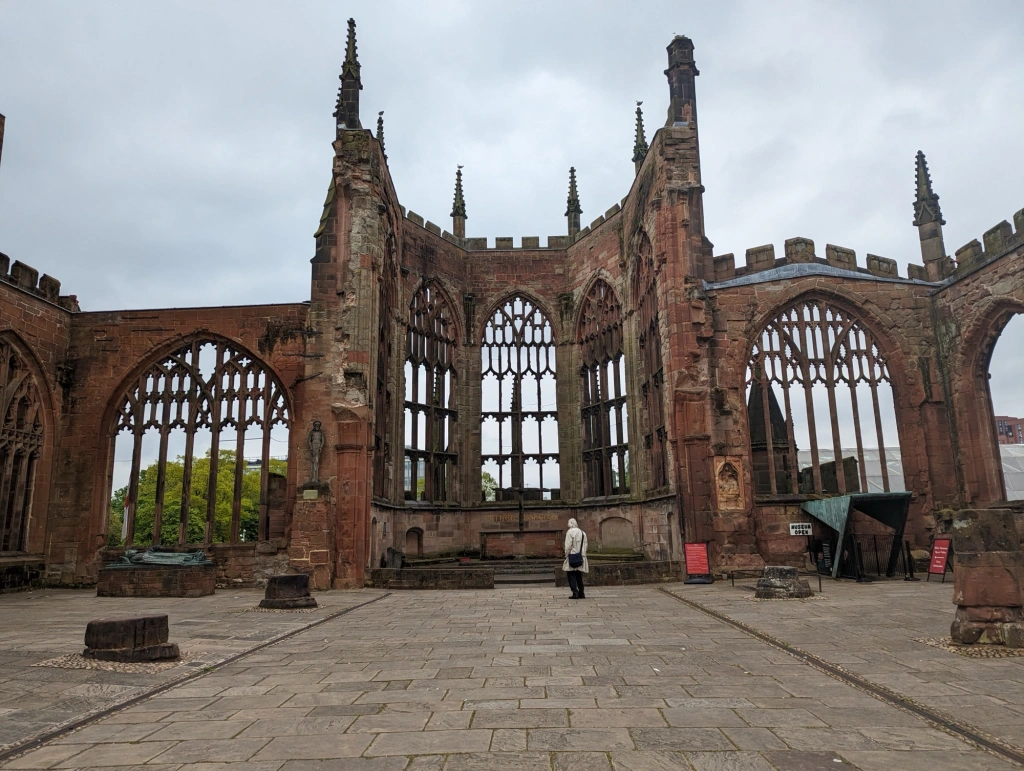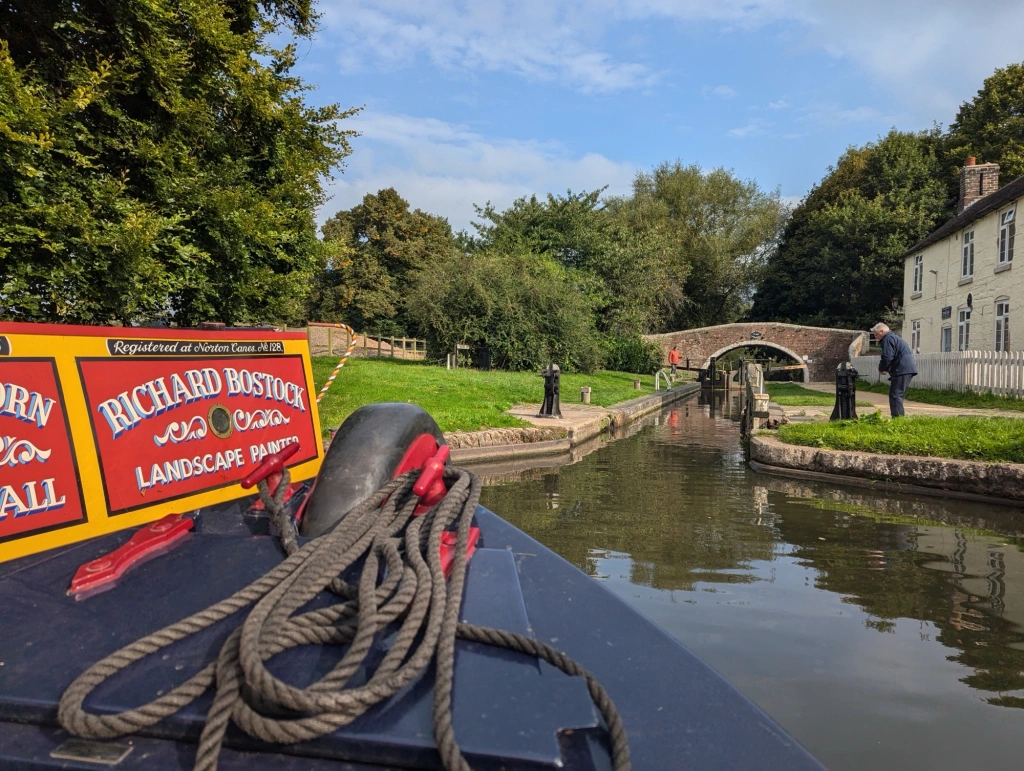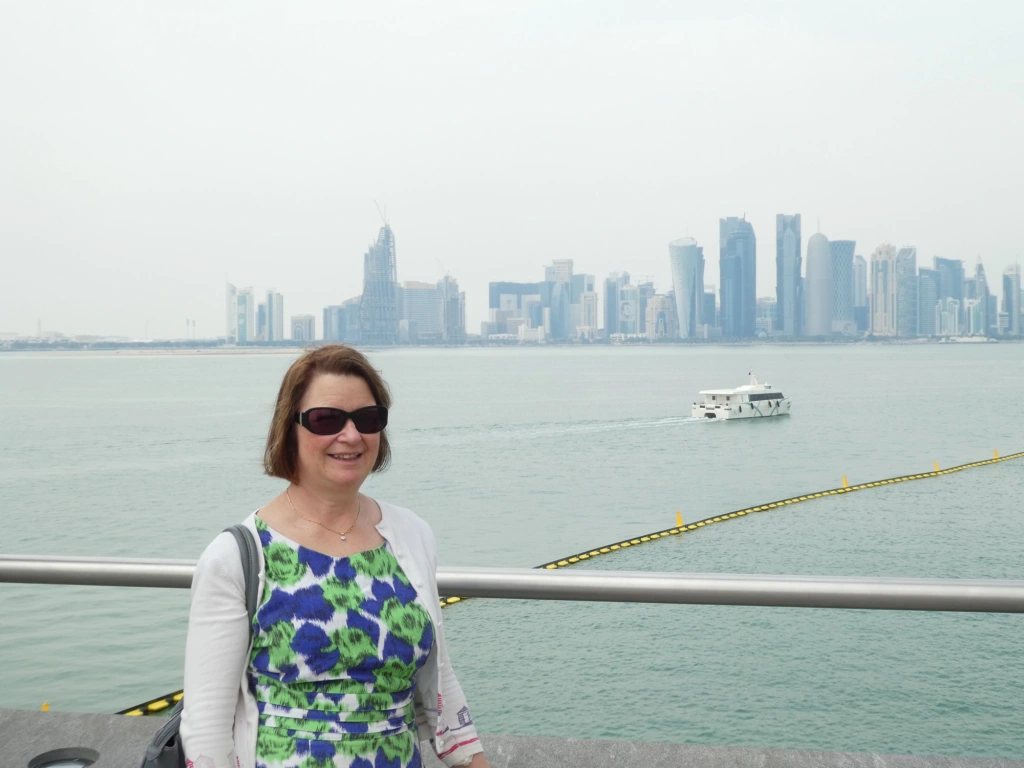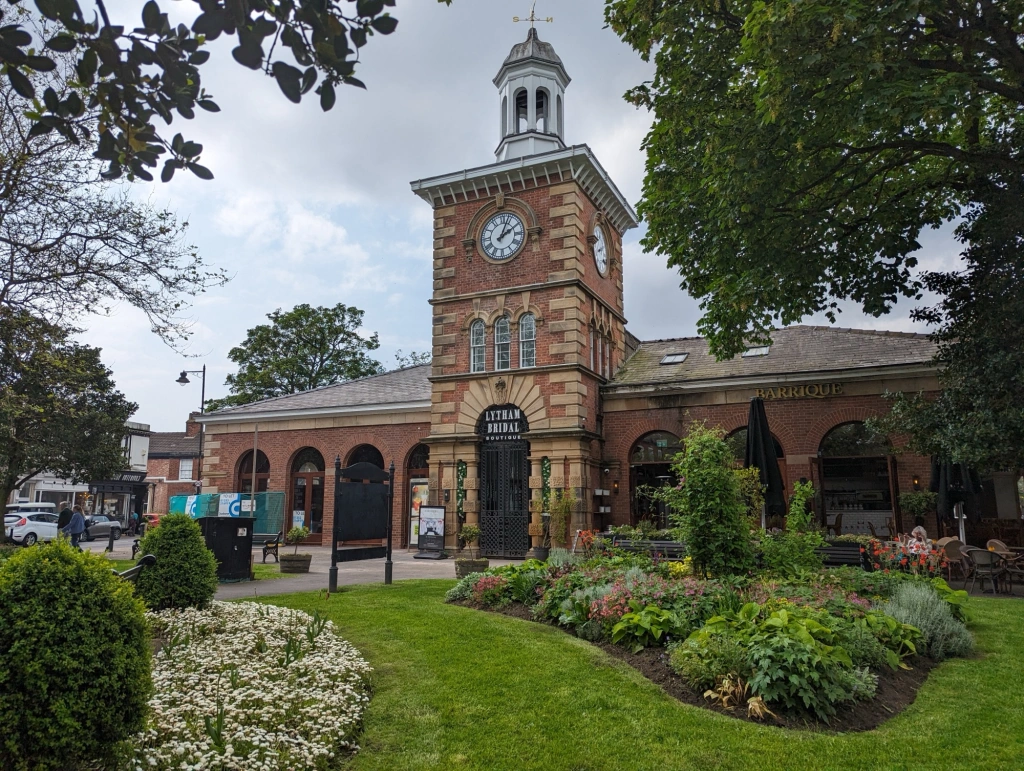Getting there:
Coventry is the perfect destination for a city break as it’s easy to get to and close to the motorway network. If you’re arriving by car I suggest parking at the newly opened station multi-storey car park as its only £8 per 24 hours and just a few minutes walk from the main attractions. For visitors preferring to travel by train, Coventry couldn’t be better positioned on the rail network as there are frequent intercity services to and from London Euston with a journey time of just over an hour. With regular services also connecting Manchester, Birmingham and Bristol, it’s a great place for a weekend away.
Stay:
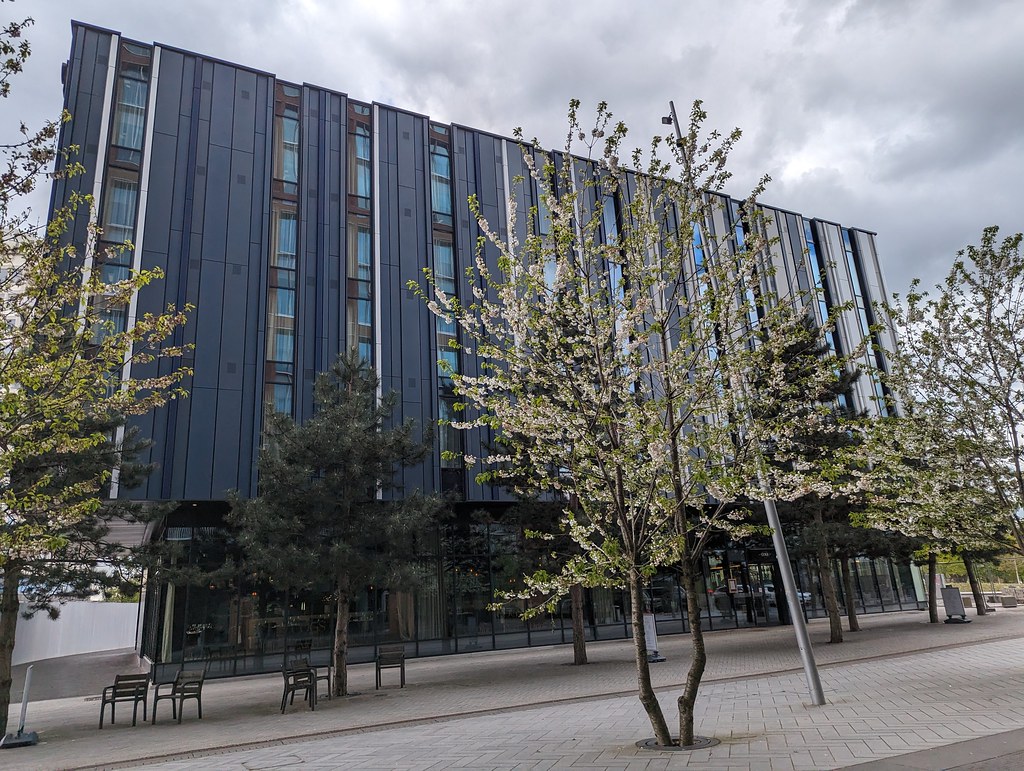
The newly opened Hotel Indigo Coventry is ideally located five minutes walk from the railway station making it a good choice for both motorists and rail travellers. The hotel’s decor reflects the culture, character, and history of the city with it’s links to the motor and cycle industries. Rooms on each floor have been tastefully designed to incorporate one or more of these themes. Enjoy dinner in the stylish Cogs Restaurant with its open kitchen where you can watch the chefs preparing your meals.
Things to see and do:
Coventry has retained some magnificent architecture conveying its rich history. From exploring the city’s cultural attractions to taking a canal side walk, enjoying afternoon tea in a medieval building or just having a wander around the shops, the city has something for everyone. Here are my suggestions for a perfect weekend break:
Coventry Transport Museum
Located in the city centre, the Coventry Transport Museum houses the largest publicly owned collection of British vehicles in the world. The first exhibits were acquired in 1937 when H.W. Bartlett gifted the city his own private collection of bicycles with cars added since 1952.
On display are 19th century bicycles, carriages and cars taking us right up to the present day with the two fastest cars on earth. I always enjoy a visit to a transport museum and was enthralled with the displays of vehicles on display here. Allow a minimum of two hours to explore this fascinating collection.
Explore the Cathedral Quarter
St. Mary’s Guildhall
Located close by is the Cathedral Quarter. Explore one of the finest guildhalls in the country. St. Mary’s Guildhall is a rare survivor of the English Civil War and also escaping the city’s devastating Second World War bombing raids. The historic building stands as a testament to Coventry’s medieval wealth and influence as it acted as the centre of power in England during the War of the Roses.
The Guildhall has housed the Crown Jewels, was the prison of Mary, Queen of Scots and has hosted famous literary figures over the years including George Eliot. Join one of St. Mary’s tour guides to explore the hall and view one of the best preserved medieval kitchens in the country. Discover that the kitchen was not only where feasts fit for Kings were prepared but also where the poor were fed and watered during Victorian times. Moving into the stunning Great Hall gaze in awe at its beautiful stained glass windows and the famous Coventry Tapestry which still hangs in its original position after more than 500 years.
Informative guides explain that the medieval wool trade made Coventry into an important centre of commerce and power. Continue into the Guildhall’s Armoury room which became the weapon store for the successful defence of the city following repeated royalist attacks, then along the Minstrel’s Gallery to the rooms on the upper floor. As well as guided tours, visitors are also able to explore themselves.
Enjoy afternoon tea in the Guildhall
Partaking of afternoon tea in the magnificent setting of St. Mary’s Guildhall’s undercroft is a memorable occasion in itself and one where you can indulge in an array of delicious food and drinks.
The British tradition of afternoon tea was introduced in 1840 by Anna Maria Russell, the 7th Duchess of Bedford who would become hungry at around 4.00 pm in the afternoon. As her household evening meal wasn’t served until 8.00 p.m. she needed something to fill the long gap between lunch and dinner. She requested that a tray of tea, bread and butter and cake be brought to her room during the late afternoon and that’s where the quintessential British custom began. We always enjoy afternoon tea and it felt a privilege to enjoy this afternoon treat in such a historic setting.
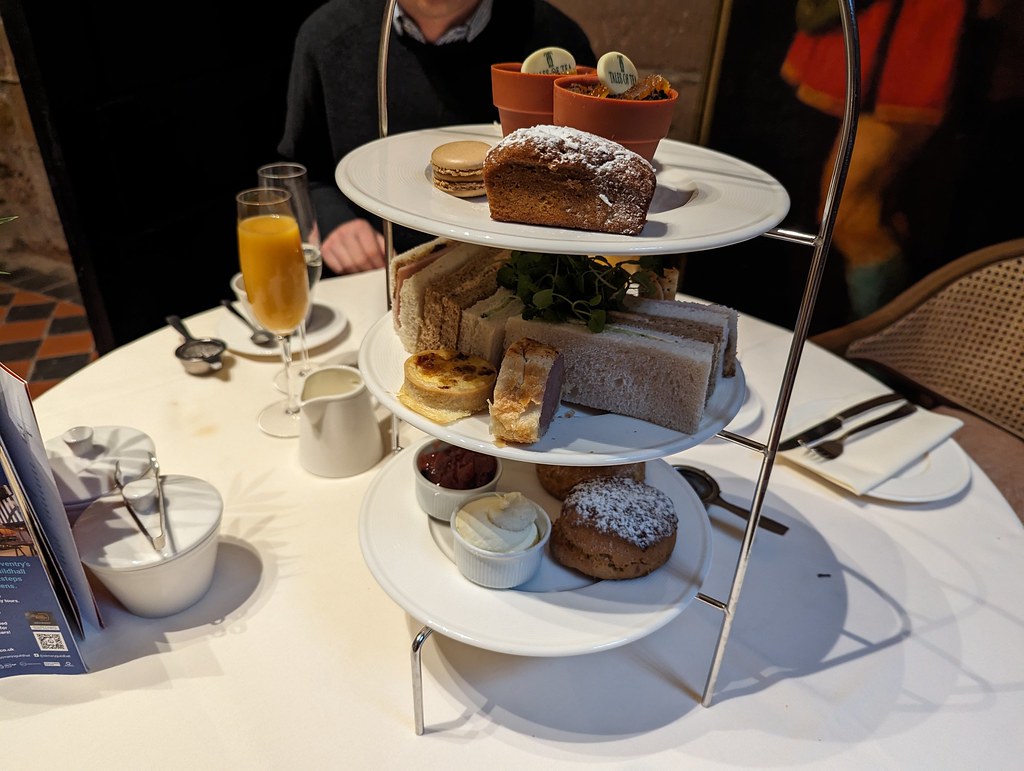
On arrival, we were led to a corner table which had been laid ready for us. We started in style sipping glasses of Prosecco whilst waiting for our tea to be prepared. A traditional three tier plate soon arrived containing dainty finger sandwiches filled with poached salmon, cream cheese and cucumber and ham with chutney. Alongside the sandwiches were delicious slices of sausage roll and cheese and tomato tartlets. Moving on to sweet treats, we feasted on warm scones with jam and clotted cream and after glasses of Buck’s Fizz, a little rest and several cups of Earl Grey tea we felt ready to tackle the top tier’s delicacies comprising a coffee macaron, a mini ginger and lemon loaf cake and last but not least an edible flower pot. The flower pots looked so realistic as they were filled with Belgian chocolate mousse and topped with chocolate soil. Rather than a traditional slice of Victoria Sandwich cake, these flower pots were the stars of the show and tasted delicious too!
Coventry Cathedral
The current cathedral first opened in 1962 welcoming thousands of visitors each year. The original cathedral known as St Michael’s was built between the late 14th century and early 15th century and now stands in ruins as it was bombed almost to destruction during the massive attack on the city by German bombers on the night of 14th November, 1940.
The bombed out remains and facade of the old church have been kept intact and stand next to the new church as a reminder of the futility of war. Coventry Cathedral has long been recognised as a symbol of peace and reconciliation. Entrance free.
Blitz Museum
Located in the corner of the Cathedral Ruins, the Blitz Museum is free to visit and a treasure trove of 1940’s memorabilia and artefacts. We started our visit by watching a video about the 1940 Coventry Blitz sitting in a recreated school room. We then followed a self guided tour then through a typical house furnished as it would have been in the 1940’s.
Statue of Lady Godiva
Located on Broadgate stands the statue of Coventry’s famous Lady Godiva. The legend of Coventry’s famous woman dates back to the 13th century when it is believed that Lady Godiva rode through the streets of Coventry naked with just her long blonde hair covering her modesty. Her reason for doing this was said to have been in protest against her husband Leofric planning to impose higher taxes on his tenants. It is claimed that he would not impose the taxes if she carried out this deed. The name ‘Peeping Tom’ was said to originate from someone who, rather than politely looking away when she rode through the town, watched her and was said to have been struck blind. Fact or fiction both Lady Godiva and Peeping Tom entered folklore as being part of Coventry’s cultural history.
Draper’s Hall
Drapers’ Hall was constructed between 1831-32 to be the headquarters of the Coventry Drapers’ Guild. It wasn’t open to the public on the day of our visit but does play host to a music and events programme befitting the splendour of the newly-restored Regency building.
Herbert Art Gallery and Museum
An excellent museum documenting the history of the city on the ground floor with an art gallery and temporary exhibitions upstairs. We found the history section the most interesting as it is divided into three sections. Starting with City of Spires – Medieval Coventry this gallery explores life in the city between 1450 to 1509 when Coventry was the largest city in the Midlands and one of the most important in England.
The next gallery City of Industry – Victorian Coventry documents the city’s Victorian watchmaking and ribbon weaving industries before moving on to the introduction of its cycle and motor manufacturing industries which were to transform the city. The final gallery 1939 to the Present Day relates the city’s history from wartime to the present day focussing on the boom period of the 1950’s and 1960’s and of the industries which provided this wealth.
Dippy the Dinosaur left its home of over 100 years at the Natural History Museum in London and is currently on display in the entrance foyer until February 2026 making a visit to the museum very popular with young families. Herbert Art Gallery and Museum
Council House
Construction of this magnificent building began in 1913 but was inevitably held up during the Great War of 1914 – 1918 and not officially opened until June 1920. On either side of the entrance are large figures of Earl Leofric of Mercia and his wife, Lady Godiva whilst above stands the figure of Justice. The grandiose interior has a fine curving staircase leading to the Council Chamber on the first floor. The building is open to the public for the annual Heritage Open Days event in September. Highlights include the Council Chambers, Lord Mayor’s hospitality suite and the Lady Mayoress Parlour.
Coventry Canal Basin
Enjoy a stroll through the city centre to the canal basin. The Coventry Canal was once a key trade route in the city and is now a popular place for a peaceful stroll. Follow the towpath passing former mills and view the sculpture commemorating James Brindley 1716-1772). An engineer by trade, Brindley played an essential role in shaping the way canals were built during the Industrial Revolution.
Slightly further afield:
Stratford-upon-Avon
Enjoy a day out in nearby Stratford-upon-Avon, just 17 miles from Coventry. The charming medieval town is famous for being the birthplace of William Shakespeare. Highlights include Shakespeare’s Birthplace, School Room, Guildhall and Anne Hathaway’s Cottage.
Aside from Shakespeare take time out to visit the Stratford Butterfly Farm:, an indoor garden filled with exotic butterflies fluttering by in colours ranging from vivid blue to yellow and crimson. As well as butterflies, mini beasts, reptiles, snakes and amphibians can be seen.
In the discovery zone visitors are able to observe the life cycle of a butterfly and to occasionally see a butterfly hatch from its pupa. It’s delightful for all ages.
Two miles outside of Stratford lies Shakespeare Distillery, an artisan spirit producer of a range of premium gins and rums. Join one of their informative distillery tours which explain the distilling process beginning in the still room and continuing through to bottling and labelling.
The tour ends with sampling a selection of gins and rums and then enjoying a full-size one of your choice. Drivers don’t miss out as they can take home a miniature bottle. The distillery also offers gin school and cocktail making classes.
British Motor Museum
The British Motor Museum lies just off the M40. This vast museum is home to the world’s largest collection of historic British cars displaying more than 400 British classic cars celebrating the past, present and future of British motoring.
The collection tells the story of the motor car and over a hundred years of its industry in the West Midlands. Free guided tours are available at certain times of day and either joining one of these or wandering around on your own it’s a fascinating museum.
I hope this travel guide has inspired you to visit Coventry, with so much to offer the city makes for an excellent short break.

